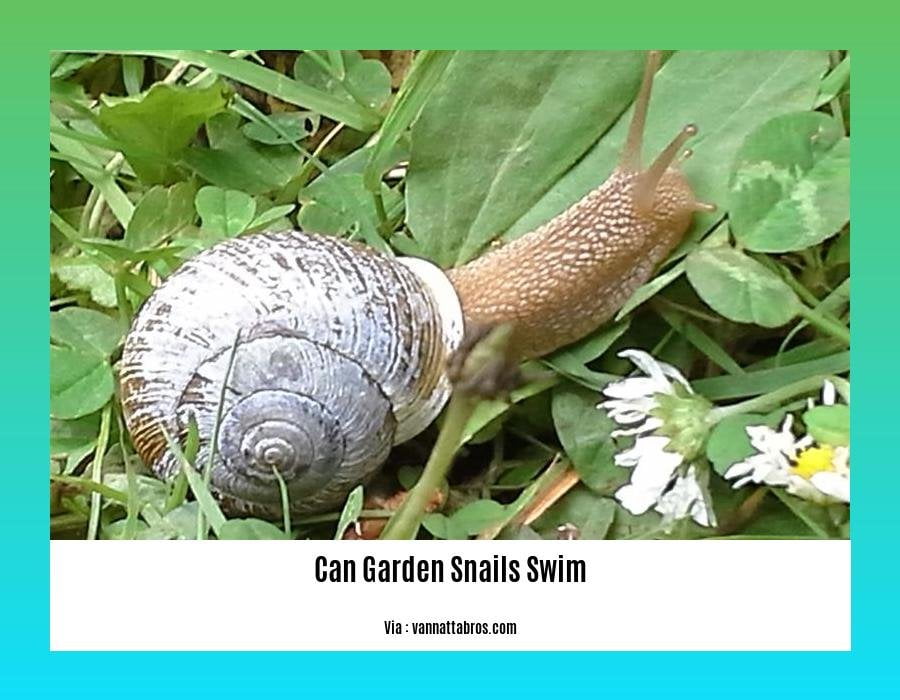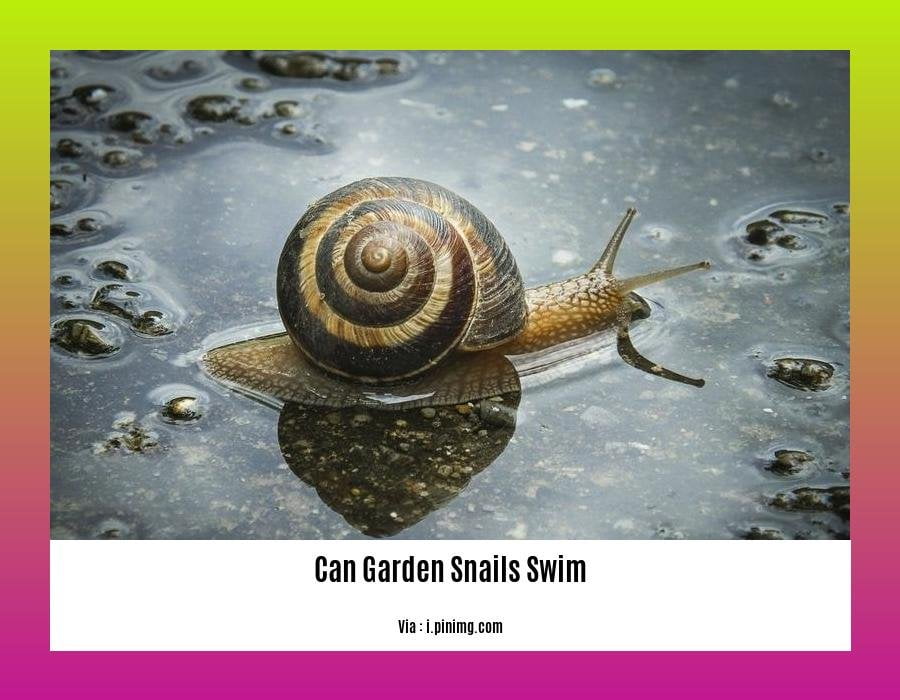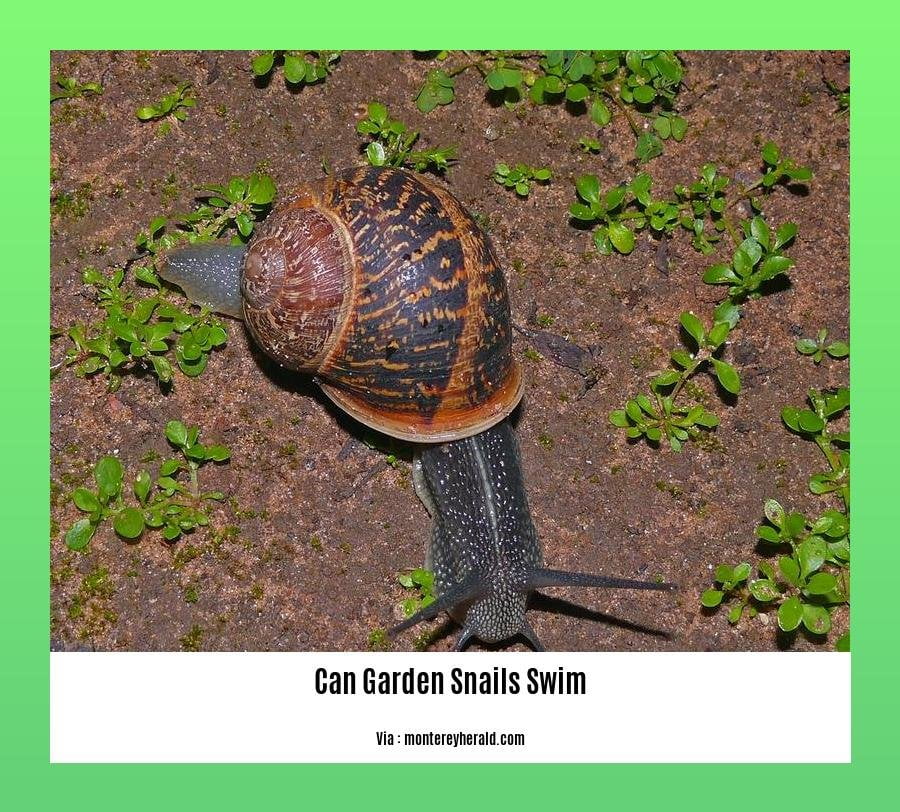Let’s get wet and wild and learn about garden snails’ swimming skills. Are they born swimmers, or do they need a little help to float? Dive into the world of these slimy creatures and uncover the secrets of their water-bound adventures. We’ll dive into their biology, their aquatic habitats, and the tricks they use to keep their heads above water. So, grab a snorkel, put on your goggles, and let’s explore the depths of garden snail swimming!

Can Garden Snails Swim?
Have you ever wondered if those slow-moving garden snails can actually take a dip in the water? Let’s dive into the answer!
Garden snails, with their adorable shells and unhurried nature, are terrestrial creatures. Unlike their aquatic cousins, they’re not exactly built for swimming. Their heavy shells and lack of breathing equipment (gills) make them poor performers in water.
So, if you drop a garden snail into a pond or pool, don’t expect it to start doing butterfly strokes. Instead, it’ll most likely struggle to stay afloat. Their shells fill up with water, weighing them down like mini anchors.
However, snails do have a secret weapon: their slimy skin. It allows them to absorb oxygen right from the water, so they can survive short dips. But remember, they’re not water babies. If they’re submerged for too long, they’ll start to drown.
Now, let’s talk about their snail buddies who live in water. Freshwater snails have fancy gills that let them breathe underwater. And sea snails, you guessed it, love the salty ocean life.
Here’s a quick tip: If you find a garden snail in your bathroom or aquarium, don’t panic. Just scoop it out gently and place it in a damp, cozy spot. They’ll be much happier there than in the water.
Garden snails may seem harmless, but did you know they have the potential to be deadly? Discover the truth about whether or not garden snails can kill you. Find out more here.
Have you ever wondered if land snails can swim? Dive into the fascinating world of these slimy creatures and learn about their surprising abilities. Check it out here.
Curious about whether or not painted dogs can be domesticated? Uncover the truth about these beautiful and unique animals. Don’t miss out, learn more here.
Sea turtles are awe-inspiring creatures, but can they pose a threat to humans? Discover the answer to the question “Can sea turtles kill you?” Dive into the details here.

Can Snails Breathe Underwater?
Do you know that some snails live in the ocean and others on land? It’s a fascinating world where these slimy creatures have evolved in different ways to breathe in different environments. Let’s dive into the details and find out if snails can breathe underwater.
Land Snails: Air Breathers
The snails you often see in your backyard or garden are called land snails. They have lungs, just like us humans, and they breathe air. If you put a land snail in water, it will eventually drown because it can’t breathe through its lungs while submerged.
Aquatic Snails: Water Breathers
Sea snails, on the other hand, live in the ocean and have gills instead of lungs. Gills are special organs that allow them to breathe oxygen from the water. They’re like underwater breathing straws, and they’re essential for sea snails to survive in their aquatic homes.
Freshwater Snails
There’s also a type of snail called a freshwater snail that lives in ponds, rivers, and lakes. Freshwater snails have gills too, which help them breathe underwater. They’re not as well-adapted to living in the ocean as sea snails, but they still need water to survive.
Can Snails Swim?
While sea snails and freshwater snails can breathe underwater, they’re not great swimmers. They’re built for crawling and gliding on land or the bottom of water bodies, and their slow, land-adapted bodies make it challenging for them to swim long distances.
Table: Snail Breathing Systems
| Snail Type | Breathing Organ | Habitat |
|---|---|---|
| Land Snails | Lungs | Land |
| Sea Snails | Gills | Ocean |
| Freshwater Snails | Gills | Ponds, rivers, lakes |
Human Connection
Snails are fascinating creatures that remind us of the diversity of life on Earth. Their ability to adapt to different environments highlights the incredible power of evolution. The next time you see a snail crawling along, take a moment to appreciate its unique breathing system and its role in the intricate web of life.
Habitat Adaptations of Different Snail Species
Snails may look slow and simple, but they’ve got some cool tricks up their shells to survive in different homes.
Land Snails
Land snails like your garden snail are not the best swimmers. They have lungs and need air to breathe, so they’re not fans of being underwater for long. They’ll drown if they go too deep.
Aquatic Snails
Water snails are a different story. They have gills that let them suck oxygen from water, so they can swim around all day long. They can live in lakes, rivers, and even the ocean.
Saltwater Snails
Saltwater snails are tough cookies. They can handle extreme temperatures and saltiness. Some of them even live near volcanoes in the ocean where the water is super hot and full of chemicals.
Desert Snails
Desert snails need to be careful with water. They live in super dry places, so they have to save every drop. Their shells are extra thick to keep the water in, and they can even hibernate when it’s too dry.
Special Tricks
Snails also have some nifty tricks to keep themselves from drying out. They make a slimy barrier to close up their shell openings, and some species even bury themselves under the ground to stay cool and moist.
So, there you have it! Snails may be slow-moving, but they’re packed with adaptations that let them live in some pretty crazy places.
Water Management for Garden Snails
Meet the Garden Snails! These land-loving critters aren’t known for their swimming skills, unlike their water-dwelling kin. Curious? Let’s explore their relationship with water below the surface.
Garden snails have lungs, not gills, so they breathe air. This means they can’t spend too much time underwater or they’ll drown. But don’t worry! They’re well-adapted to life in moist environments.
How do they quench their thirst? They absorb water through their skin and the bottom of their feet! Providing them with a shallow dish filled with water or misting their home a few times a week keeps them hydrated.
Now, here’s the twist: Even though they can’t swim, garden snails are pretty good at navigating damp places! Their secret weapon? Their sticky feet! They secrete mucus, like a built-in adhesive, that lets them crawl along the surfaces of ponds or moist plants. So, while they won’t be splashing around in the waves, you might catch them crawling along the edge of your garden pond.
Water Management Tips:
- Keep it shallow: Provide a water dish that’s shallow enough for snails to easily access.
- Mist it up: Mist their enclosure every few days to maintain moisture levels.
- Don’t overwater: Avoid creating puddles or overly wet conditions, as this can lead to problems like mold.
Key Points:
- Garden snails can’t swim due to their lungs.
- They absorb water through their skin and feet.
- They have sticky feet that allow them to crawl along moist surfaces.
- Provide shallow water and misting for hydration.
Remember, these fascinating creatures may not be Olympic swimmers, but they’ve got their own unique way of managing water in their land-bound adventures.
FAQ
Q1: Can garden snails swim?
A1: No, garden snails cannot swim and may drown if they are submerged in deep water. They can survive in water for short periods (a few hours) if their habitat dries up, but they cannot breathe underwater.
Q2: Can snails breathe underwater?
A2: No, garden snails cannot breathe underwater due to having only lungs. Aquatic snails have gills that allow them to breathe and live in water.
Q3: How do different snail species adapt to their habitats?
A3: Different types of snails have varying abilities to survive in water. Freshwater snails and sea snails can breathe underwater, while land snails cannot. Desert-adapted snails have specific adaptations to improve their water economy, and aquarium snails are adapted to living underwater full-time.
Q4: How do I manage water for garden snails?
A4: Garden snails need water for hydration and movement. It is recommended to mist them and their enclosure with water every other day to maintain moisture and provide a shallow water dish for them to soak in. Avoid prolonged exposure to water, as this can be harmful to them.
Q5: What are some unique characteristics of garden snails?
A5: Garden snails have a sticky foot organ that allows them to crawl along surfaces and a retractable shell that protects them from predators and the elements. They are hermaphrodites, meaning they have both male and female reproductive organs, and can lay up to 100 eggs at a time.
- China II Review: Delicious Food & Speedy Service - April 17, 2025
- Understand Virginia’s Flag: History & Debate - April 17, 2025
- Explore Long Island’s Map: Unique Regions & Insights - April 17, 2025
















